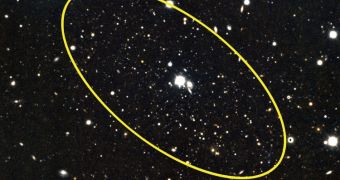In a recent study conducted at the outskirts of our neighboring galaxy, Andromeda, astronomers were able to discover two new dwarf galaxies, which they named Andromeda 28 and 29. Experts hope to use these formations to reveal some of the mysteries associated with dark matter.
This is the stuff that makes up nearly a quarter of the entire Universe. But, while its existence has been proposed some time ago, no clear evidences that it exists have ever been obtained. It is widely believed that dark matter interacts with normal matter only through the force of gravity.
Astrophysicists have took nearly all approaches imaginable to detecting the stuff. They built detectors underground, and deployed specialized satellites in space. They even took to analyzing the distribution of unusual gravitational pulls in small and large galaxies alike.
In a recent investigation, experts found that two dwarf galaxies located far away from Earth displayed uniformly-distributed dark matter concentrations, rather than the stuff being distributed at its core.
This was an unexpected finding, and one that made experts reconsider their predictions of how dark matter interacts with regular, baryonic matter. Now, studies of Andromeda 28 and 29 may help solve this cosmic mystery, Space reports.
The formations orbit Andromeda at a distance of about 600,000 light-years from its core, and are around 1.1 million light-years away from Earth. Andromeda itself is about 2.5 million light-years away from us, and is scheduled to start colliding with the Milky Way in about 5 billion years.
“These faint, dwarf, relatively nearby galaxies are a real battleground in trying to understand how dark matter acts at small scales. The stakes are high,” says a statement released by University of Michigan in Ann Arbor astronomer Eric Bell.
He was the leader of the new investigation, which was conducted using data collected by the Sloan Digital Sky Survey (SDSS). Confirmations came from subsequent studies, conducted using the Hawaii-based Gemini North Telescope.
“The models predict far more dark matter halos than we observe galaxies. We don't know if it's because we're not seeing all of the galaxies or because our predictions are wrong,” astronomy PhD student and study team member Colin Slater adds.
“The exciting answer would be that there just aren't that many dark matter halos. This is part of the grand effort to test that paradigm,” Bell goes on to say. The team's paper will appear in the November 20 issue of the esteemed Astrophysical Journal Letters.

 14 DAY TRIAL //
14 DAY TRIAL //